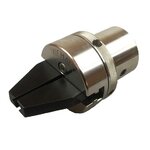I'm not a heavy-duty pen maker - I may do two or three kit pens per year for friends. However, I do make quite a few "12 cent" pens (as Capt Eddie calls them) - redressed BIC pens that I give away as thank-you's mainly in stores where the clerks are exceptionally friendly and helpful.
Drilling for 12-cent pens is tricky because the required bit is thin and long - and it is necessary to drill a hole almost 5" deep. When drilling deep holes in wood, there is a tendency for the bit to wander off-axis; basically, it will try to follow grain boundaries inside the wood, remaining in the softer 'summer growth' areas; this problem is aggravated as the hole becomes deeper, and it's a real headache with thin, flexible bits. So keeping the bit on-axis is a real challenge. Nominally, a BIC refill requires a 3/32" hole; I actually drill using a 9/64" bit that is 6" long, and then bore the end of the pen out with a 3/32" bit after it has been completed. I find the process of turning a pen enlarges the hole very slightly, and if I drill initially with the 3/32" bit, the refill will be a bit sloppy in the hole later (although that problem can be solved by wrapping the refill with some plumber's teflon tape).
When drilling holes in blanks, it is necessary to withdraw the bit and clear the swarf periodically - probably every 1/2" of advance. If swarf builds up in the flutes of the bit, it will cause friction that will heat the blank. This is true for kit pens as well as 12-cent pens. If blanks overheat, they can crack. DAMHIKT
Anyway, the process I use for drilling probably would work for kit pens where the bit is much larger. I mount the blank between centers, and turn to round. I also turn a spigot on one end. Then, I remount the blank using #1 jaws in a scroll chuck to grip the spigot. To drill the hole,
1. I start with a center bit, making sure that it is centered in the dimple from the initial between-centers turning before I lock down the tailstock. I drill only deep enough to create a starting point for the next step. Lathe speed is <500 r/min.
2. I replace the center bit with a standard 'jobber length' 9/64 bit that I chuck up as far into the jacobs chuck as possible, exposing only 1/2-3/4" of flute. I center the bit into the starter hole from step one before locking down the tailstock, and have the lathe spinning at less than 500 r/min. I advance the tailstock ram very slowly so that the bit actually cuts the hole before tit advances into the hole. Don't force the advance - let the bit do the work!
3. After using the exposed portion of the jobber-length bit, I replace it with a 6" (so-called 'aircraft bit') bit. Again, I center the bit in the hole before locking down the tailstock and advance the bit very slowly. At this point, I may speed up the lathe a little so that it cuts faster than I advance the bit into the blank, but to avoid overheating the wood, I may also apply a little paraffin wax to lubricate the shank and minimize friction (with 12-cent pens, nothing is glued into the hole, so adding a lubricant is OK).
This seems to work for me - I won't say that I never experience an off-center hole, but my success rate with this approach is reasonably good.

